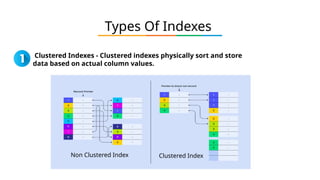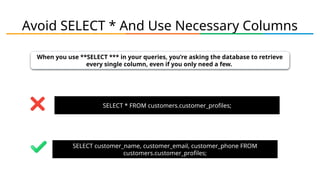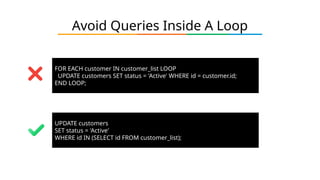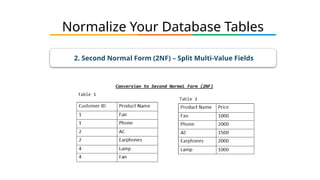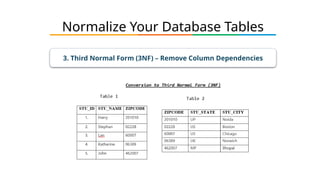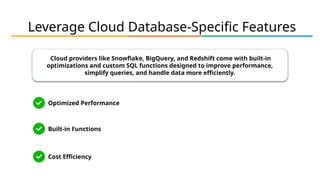SQL Query Optimization | SQL Query Optimization Techniques | SQL Basics | SQL Query | Simplilearn
- 2. Indexes For SQL Query Optimization Indexing in SQL acts as a shortcut that helps the database find and retrieve data much faster.
- 3. Types Of Indexes Clustered Indexes - Clustered indexes physically sort and store data based on actual column values. Non Clustered Index Clustered Index
- 4. Types Of Indexes Non Clustered Index Clustered Index Non-Clustered Indexes –They create a separate lookup structure that points to the actual data.
- 5. Types Of Indexes Full-Text Indexes –Full-text indexes help by storing word positions, making searches much faster instead of scanning the entire text.
- 6. How Indexing Speeds Up Queries SELECT * FROM customers WHERE name = 'John Doe'; Without an index, the query scans every row: But by creating an index on the ‘name’ column, the query runs much faster. CREATE INDEX idx_customer_name ON customers(name);
- 7. Avoid SELECT * And Use Necessary Columns When you use **SELECT *** in your queries, you’re asking the database to retrieve every single column, even if you only need a few. SELECT * FROM customers.customer_profiles; SELECT customer_name, customer_email, customer_phone FROM customers.customer_profiles;
- 8. Optimizing JOIN Operations If you use the wrong type of join, you might end up with duplicate records, slow query performance, or unnecessary data bloating your results. Understanding INNER JOIN, OUTER JOIN, LEFT JOIN, and RIGHT JOIN is crucial for writing efficient queries. Outer Joins – Use with Caution! OUTER JOIN is like keeping everything from both, even the unrelated data. It can create duplicates and bloat your dataset unnecessarily.
- 9. Optimizing JOIN Operations If you use the wrong type of join, you might end up with duplicate records, slow query performance, or unnecessary data bloating your results. Understanding INNER JOIN, OUTER JOIN, LEFT JOIN, and RIGHT JOIN is crucial for writing efficient queries. INNER JOIN only returns records where there’s a match between both tables. It keeps your dataset clean and ensures you only get the necessary data. Inner Joins – Your Best Friend!
- 10. Optimizing JOIN Operations If you use the wrong type of join, you might end up with duplicate records, slow query performance, or unnecessary data bloating your results. Understanding INNER JOIN, OUTER JOIN, LEFT JOIN, and RIGHT JOIN is crucial for writing efficient queries. SELECT customer_orders.customer_id, order_details.order_id, order_details.order_date FROM customers.customer_orders customer_orders INNER JOIN orders.order_details order_details ON customer_orders.customer_id = order_details.customer_id AND customer_orders.customer_order_id = order_details.order_id;
- 11. Optimizing JOIN Operations LEFT JOIN Vs RIGHT JOIN
- 12. Use EXISTS Instead Of IN When checking if a value exists in a smaller dataset, EXISTS is usually much faster than IN , because EXISTS stops searching as soon as it finds a match, whereas IN scans the entire dataset before deciding—making it slower, especially with large tables. SELECT * FROM orders WHERE customer_id IN (SELECT id FROM customers WHERE active = TRUE); SELECT * FROM orders o WHERE EXISTS (SELECT 1 FROM customers c WHERE c.id = o.customer_id AND c.active = TRUE);
- 13. Minimize Subqueries & Use CTEs Instead 1️ 1️ ⃣ Subqueries Can Get Messy – Using too many subqueries in SQL makes your code hard to read, debug, and optimize, just like untangling a messy ball of wires. 2️ ⃣ CTEs Make Queries Cleaner – Common Table Expressions (CTEs) break queries into readable sections, making them easier to understand, troubleshoot, and maintain— just like writing clear step-by-step instructions.
- 14. Minimize Subqueries & Use CTEs Instead SELECT MAX(customer_signup) AS most_recent_signup FROM (SELECT customer_name, customer_phone, customer_signup FROM customer_details WHERE YEAR(customer_signup) = 2023); WITH 2023_signups AS ( SELECT customer_name, customer_phone, customer_signup FROM customer_details WHERE YEAR(customer_signup) = 2023 ), Most_recent_signup AS ( SELECT MAX(customer_signup) AS most_recent_signup FROM 2023_signups )
- 15. Avoid Queries Inside A Loop When you run SQL queries inside a loop—it makes execution unnecessarily slow and inefficient. Loops like FOR, WHILE, and DO-WHILE run queries one at a time, causing repeated parsing, compiling, and execution, which hurts performance and scalability.
- 16. FOR EACH customer IN customer_list LOOP UPDATE customers SET status = 'Active' WHERE id = customer.id; END LOOP; UPDATE customers SET status = 'Active' WHERE id IN (SELECT id FROM customer_list); Avoid Queries Inside A Loop
- 17. Avoid Redundant Data Retrieval The larger the dataset, the slower the query, and the more resources you waste—which can increase costs, especially in cloud-based databases. Select Only the Needed Columns – We’ve already covered why **SELECT *** is inefficient, but it’s also important to limit the number of rows returned, not just columns. Use LIMIT to Control Output – Queries that return thousands or millions of rows can drag down performance, so always limit the results when needed.
- 18. Avoid Redundant Data Retrieval SELECT customer_name FROM customer_details ORDER BY customer_signup DESC LIMIT 100; Instead of pulling all customers, retrieve only the latest 100 signups: SELECT customer_name FROM customer_details ORDER BY customer_signup DESC LIMIT 100 OFFSET 20; Want to skip the first 20 rows and get the next 100? Use OFFSET:
- 19. How to Create A Stored Procedure? Let’s say we want to find the most recent customer signup. Instead of writing the query every time, we can save it as a stored procedure: CREATE PROCEDURE find_most_recent_customer AS BEGIN SELECT MAX(customer_signup) AS most_recent_signup FROM 2023_signups; END; EXEC find_most_recent_customer;
- 20. How to Create A Stored Procedure? Adding Parameters for Flexibility CREATE PROCEDURE find_most_recent_customer @store_id INT AS BEGIN SELECT MAX(customer_signup) AS most_recent_signup FROM 2023_signups WHERE store_id = @store_id; END; EXEC find_most_recent_customer @store_id = 1188;
- 21. Normalize Your Database Tables 1. First Normal Form (1NF) – No Nested Data!
- 22. Normalize Your Database Tables 2. Second Normal Form (2NF) – Split Multi-Value Fields
- 23. Normalize Your Database Tables 3. Third Normal Form (3NF) – Remove Column Dependencies
- 24. Monitoring Query Performance When you run SQL queries without monitoring their performance—you have no idea which queries are slowing down your database or costing you extra resources. Identifies Slow Queries Saves Costs in Cloud Databases Prevents System Slowdowns
- 25. Monitoring Query Performance Tools for Monitoring Query Performance Query Profiling Query Execution Plans Database Logs & Server Monitoring
- 26. Monitoring Query Performance Let’s say you have a slow query, and you want to analyze its performance. You can use MySQL’s EXPLAIN statement: EXPLAIN SELECT customer_name FROM customers WHERE city = 'New York';
- 27. Use UNION ALL Instead Of UNION If you use UNION, you’re double-checking every name to remove duplicates before finalizing the list. But if you use UNION ALL, you simply combine both lists as they are—faster, simpler, and without extra processing. UNION – Combines results from two tables and removes duplicates (which takes extra processing time). UNION ALL – Combines results without checking for duplicates, making it faster and more efficient.
- 28. Use UNION ALL Instead Of UNION SELECT customer_name FROM customers_2023 UNION SELECT customer_name FROM customers_2024; SELECT customer_name FROM customers_2023 UNION ALL SELECT customer_name FROM customers_2024;
- 29. Leverage Cloud Database-Specific Features Cloud providers like Snowflake, BigQuery, and Redshift come with built-in optimizations and custom SQL functions designed to improve performance, simplify queries, and handle data more efficiently. Built-in Functions Optimized Performance Cost Efficiency
- 30. Leverage Cloud Database-Specific Features Example: Snowflake’s JSON Functions SELECT json_column:customer.name::STRING AS customer_name, json_column:customer.email::STRING AS customer_email FROM orders;



